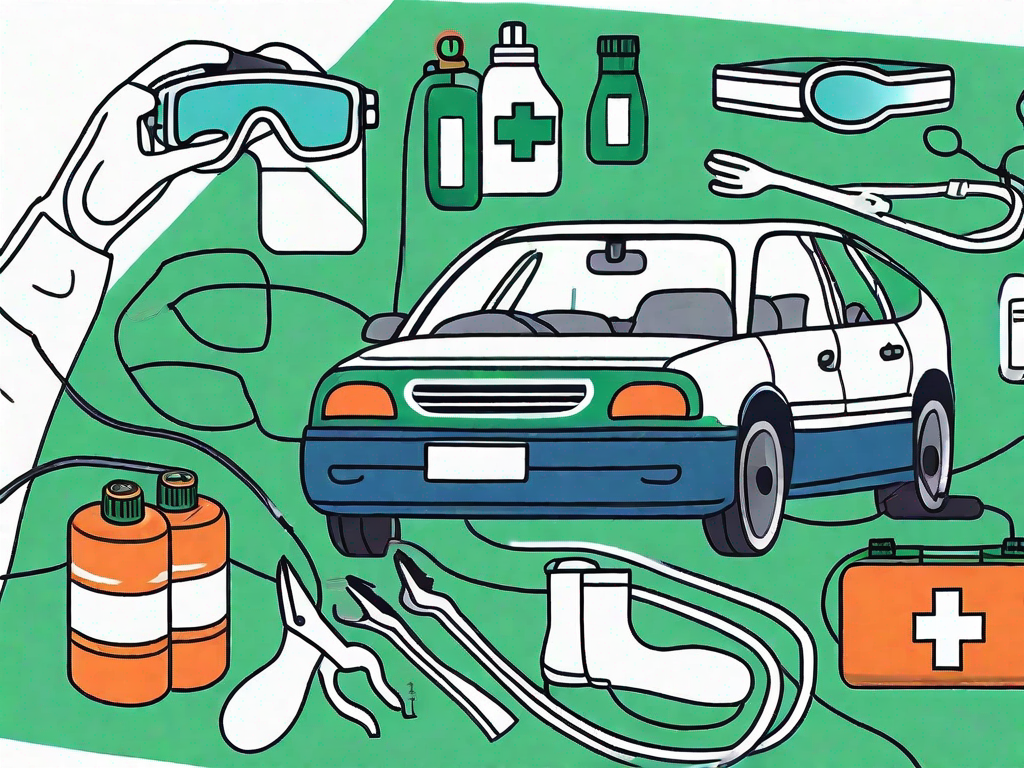Jumpstarting a car can be a lifesaver when you find yourself with a dead battery and no other means to get your car going. However, it’s important to keep safety in mind throughout the entire process. In this article, we will guide you through the step-by-step process of jumpstarting a car while prioritizing safety. So, let’s dive in and learn how to jumpstart a car safely!
Understanding the Basics of a Car Battery
A car battery is the heart of your vehicle’s electrical system. It provides the necessary power to start the engine and keeps the electrical systems running smoothly. Understanding the basics of a car battery is crucial before attempting to jumpstart your vehicle.
One important thing to note is that car batteries contain a mixture of sulfuric acid and water which produces hydrogen gas. This gas is highly flammable and can lead to an explosion if not handled and vented properly. Therefore, it’s vital to keep sparks, open flames, and smoking materials away from the battery at all times.
The Role of a Car Battery
The main role of a car battery is to supply electrical energy to the starter motor, ignition system, lights, and other electrical components. It stores electrical energy in the form of chemical energy and converts it into electrical power whenever required.
Additionally, the battery provides a stable electrical voltage to keep the engine running smoothly. It acts as a buffer and helps regulate voltage fluctuations caused by the alternator.
Identifying Signs of a Dead Battery
Before jumpstarting a car, it’s important to identify the signs of a dead battery. Common symptoms include dimmed headlights, a clicking sound when turning the key, the engine refusing to start, or complete electrical failure.
If you notice any of these signs, there’s a good chance that your battery needs a jumpstart. However, it’s always recommended to diagnose the issue properly, as a dead battery might not always be the culprit.
Essential Tools for Jumpstarting a Car
Now that we understand the role of a car battery and how to identify a dead battery, it’s time to gather the essential tools required for jumpstarting.
Choosing Quality Jumper Cables
To jumpstart a car, you’ll need a set of quality jumper cables. Look for cables with thick insulation and heavy-duty clamps. The thicker the cables, the better the flow of electricity, ensuring a quicker jumpstart.
It’s also recommended to go for longer cables, as this will give you more flexibility when positioning the vehicles. Additionally, consider investing in cables with built-in surge protection to prevent damage to your vehicle’s electrical systems.
The Importance of a Good Battery Charger
While not essential, having a good battery charger can be extremely useful. A battery charger provides a slow and steady charge to your battery, ensuring it reaches optimal levels.
A fully charged battery has a higher chance of starting the engine quickly and can prevent premature battery failure. A battery charger is a great investment for those who frequently experience battery issues or want to maintain their battery’s health regularly.
Safety Measures Before Jumpstarting
Before we dive into the jumpstarting process, let’s talk about some crucial safety measures to follow. These precautions will ensure a smooth and safe jumpstart.
Pre-Jumpstart Safety Checklist
Before proceeding, make sure to follow this safety checklist:
- Turn off both vehicles and engage the parking brakes.
- Keep ignition keys out of the cars to avoid accidental starts.
- Remove any jewelry or metal objects that may accidentally touch the battery terminals.
- Inspect the battery for any leaks, cracks, or damage. Avoid jumpstarting if the battery is damaged or leaking.
- Ensure good visibility by turning on hazard lights, especially during low-light conditions or at night.
Correct Positioning of Cars
The positioning of the cars during jumpstarting is essential for safety and optimal electrical transfer. Here’s how to position the vehicles:
- Ensure that both vehicles are not touching each other.
- Place the vehicles in park (for automatic transmissions) or neutral (for manual transmissions).
- Position the vehicles facing each other, with the battery of the assisting vehicle as close as possible to the battery of the stalled vehicle.
- Make sure there is enough space to open the hoods without them touching.
Step-by-Step Guide to Jumpstarting a Car
Now that we have covered the essential tools and safety measures, let’s proceed with the step-by-step guide to jumpstarting a car:
Connecting the Jumper Cables
Follow these steps to connect the jumper cables:
- Connect one end of the red positive (+) cable to the positive terminal of the dead battery.
- Attach the other end of the red positive (+) cable to the positive terminal of the charged battery.
- Connect one end of the black negative (-) cable to the negative terminal of the charged battery.
- Attach the other end of the black negative (-) cable to an unpainted metal surface away from the battery on the dead vehicle. This will serve as the grounding point.
Ensure all the connections are secure and the clamps are gripping the terminals tightly.
Starting the Engines
Once the cables are connected, it’s time to start the engines:
- Start the engine of the assisting vehicle and let it run for a few minutes.
- Attempt to start the engine of the stalled vehicle. If it doesn’t start, wait for a few more minutes to allow the dead battery to charge.
- Once the stalled vehicle starts, let both engines run for a while to ensure the battery receives a proper charge.
Remember, do not remove the jumper cables while the engines are running. Turn off both vehicles before removing the cables.
Post-Jumpstart Procedures
Disconnecting the Cables Safely
Follow these steps to safely disconnect the jumper cables:
- Start by turning off the engines of both vehicles.
- Remove the black negative (-) cable from the grounded point on the previously stalled vehicle.
- Next, remove the black negative (-) cable from the negative terminal of the charged battery.
- Remove the red positive (+) cable from the positive terminal of the charged battery.
- Finally, disconnect the red positive (+) cable from the positive terminal of the previously stalled vehicle.
Remember to store the cables properly to prevent tangling or damage.
Checking the Battery Health Post-Jumpstart
While jumpstarting a car can get your vehicle running, it’s important to further inspect the battery’s health to prevent future issues. Consider taking your car to a trusted mechanic or an auto parts store to get the battery checked. They can perform tests to determine the condition of your battery and whether it needs replacement.
Regular maintenance, such as cleaning the battery terminals, can also help extend the life of your battery. Additionally, make sure to check the charging system and electrical connections periodically to ensure optimal battery health.
Jumpstarting a car can save the day, but it’s crucial to approach it with safety as the top priority. By following the steps outlined in this article, you’ll be able to jumpstart a car confidently and safely. Remember, if you’re unsure or uncomfortable with the process, it’s always wise to contact a professional for assistance. Stay safe on the roads!



